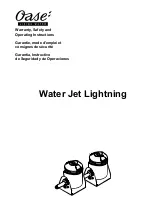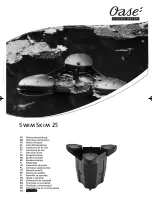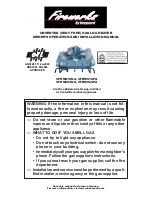
LP-644 Rev. 8.10.17
56
Display
Condition
Diagnostic
Possible Corrective Actions
Nothing appears on the
display control panel but
the fan runs at full speed
Control is not
receiving power
Check wiring for short circuit or incorrect
wiring
Correct wiring per wiring diagram
including connection of transformer to
the control.
Check transformer connection to the
control per wiring diagram. Check for 14V
output of panel wire.
Push the Power button on the control
panel
Nothing appears on the
display control panel
and no other water
heater components are
operating
Control is not
receiving 120V
power
Ensure service switch and/or circuit
breaker to water heater is turned ON
Turn on service switch or circuit breaker to
power water heater
Is there 120V at the service switch
Troubleshoot and correct the power
supply to the manual switch
Is the ON/OFF switch inside the water
heater cabinet is turned on
Turn ON the manual power switch inside
the water heater cabinet
Check for 120V at the line voltage terminal
block located inside the water heater
cabinet
Correct wiring inside the water heater
cabinet using the wiring diagram in the
installation manual
Inspect the fuse. Replace as necessary
Replace the fuse with the proper part
found in the replacement part section of
this manual. If fuse blows again, recheck
the wiring per diagram
Nothing appears on the
display control panel,
but the water heater is
operating
Occurs when
communication is
lost from the control
to the display
Check for loose connections and proper
pin alignment / engagement on the
control’s plug
Check for continuity on the wire harness
from the display to the control. See repair
parts section for proper replacement part.
Cycle power off and on using water heater
power switch and check for operation
Replace with new display module.
See repair parts section for proper
replacement part.
Display repeatedly goes
through initialization
sequence
Occurs when control
does not receive
signal from fan
Cycle power off and on using appliance
power switch and check for operation
Replace fan
Table 36 - Diagnostics and Suggested Corrective Actions
Part 11 - Start-Up
A. Check / Control Water Chemistry
Chemical imbalance of the water supply may affect efficiency and
cause severe damage to the appliance and associated equipment.
Water quality must be professionally analyzed to determine
whether it is necessary to treat the water. Various solutions are
available to adjust water quality. Adverse water quality will affect
the reliability of the system. In addition, operating temperatures
above 135
o
F will accelerate the build-up of lime scale and possibly
shorten appliance service life. Failure of an appliance due to
lime scale build-up, low pH, or other chemical imbalance IS NOT
covered by the warranty.
Thoroughly clean and flush any system before installing the water
heater.
The water must be potable, free of corrosive chemicals, sand,
dirt, and other contaminates. It is up to the installer to ensure the
water does not contain corrosive chemicals or elements that can
damage the heat exchanger. Potable water is defined as drinkable
water supplied from utility or well water in compliance with EPA
secondary maximum contaminant levels (40 CFR Part 143.3). If
the water contains contaminants higher than outlined by the EPA,
water treatment is recommended and additional, more frequent
maintenance may be required. See Table 1.
If you suspect that your water is contaminated in any way,
discontinue use of the appliance and contact an authorized
technician or licensed professional.
Contaminant
Maximum Allowable Level
Total Hardness
(Commercial Use - Above 140
o
F
water temperature)
120 mg/l
(7 grains/gallon)
Aluminum
0.05 to 0.2 mg/l or PPM
Chloride
100 mg/l or PPM
Copper
1 mg/l or PPM
Iron
0.3 mg/l or PPM
Manganese
0.05 mg/l or PPM
pH
6.5 - 8.5
Sulfate
205 mg/l or PPM
Total Dissolved Solids (TDS)
500 mg/l or PPM
Zinc
5 mg/l or PPM
Dissolved Carbon Dioxide (CO2)
15 mg/l or PPM
Table 37 - Water Quality Specifications
*NOTE:
It is recommended to clean the heat exchanger at least once
a year to prevent lime scale buildup. To clean the heat exchanger,
follow the maintenance procedure in this manual.
Clean system to remove sediment*
1. You must thoroughly flush the system (without water heater
connected) to remove sediment. The high-efficiency heat exchanger
can be damaged by buildup or corrosion due to sediment.
2. Flush system until water runs clean and you are sure piping is free
of sediment.
Содержание CGH-199*
Страница 40: ...LP 644 Rev 8 10 17 40 Figure 38 Electrical Wiring Diagram...
Страница 41: ...LP 644 Rev 8 10 17 41 Figure 39 Ladder Diagram...
Страница 69: ...LP 644 Rev 8 10 17 69 Notes...















































